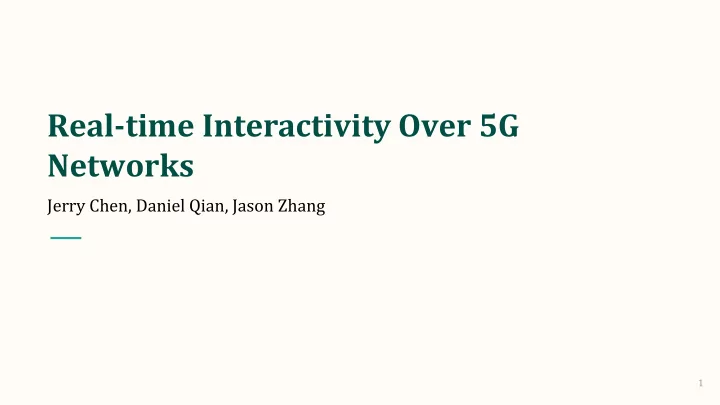

Real-time Interactivity Over 5G Networks Jerry Chen, Daniel Qian, Jason Zhang Spring 2020 Jerry Chen | Dan Qian | Jason Zhang 1
Background New 5G mobile networks will provide more bandwidth to users, but more importantly, will also provide much lower latency (according to carriers) - 5G: Below 10ms - 4G LTE: 40-100ms This is beneficial for applications in which users must interact with each other in real time (also autonomous vehicles) We wanted to investigate how these properties can be used by developing our own real time protocol Spring 2020 Jerry Chen | Dan Qian | Jason Zhang 2
Our Approach 1. Research and experiment with characteristics of cellular networks 2. Develop a real time, proactive, bandwidth estimation protocol that works over cellular links 3. Implement protocol in a proof of concept Android application that also demonstrates interactivity 4. Compare our protocol’s performance on 5G networks and various 4G LTE carriers Spring 2020 Jerry Chen | Dan Qian | Jason Zhang 3
Cellular vs Wired Links From research and initial experiments: Builds up large queues instead of dropping → latency spikes! - - Necessitates proactive bandwidth estimation - We will demonstrate this later - Packet bunching - Base towers can aggregate packets - Mobile phones use a separate baseband processor to handle network I/O - Not sure exactly how it works, but out of our control Note our model assumes the cellular link is always the bottleneck Spring 2020 Jerry Chen | Dan Qian | Jason Zhang 4
Protocol Our initial idea was to send a instantaneous burst of packets and measure interarrival times of the burst Sender Receiver (Actual Bandwidth) However we ran into issues due to packet bunching Spring 2020 Jerry Chen | Dan Qian | Jason Zhang 5
Protocol Instead simply periodically send at higher (2x) rate. Can still detect underutilization of capacity. Sender Receiver (Actual Bandwidth) Spring 2020 Jerry Chen | Dan Qian | Jason Zhang 6
Protocol If at any point the bandwidth measured on the receiver side is less than sent, we send a control message and back off. Notify sender Sender Receiver (Slowdown) Spring 2020 Jerry Chen | Dan Qian | Jason Zhang 7
Protocol - Implementation Details Sender - Appends sending rate to header on every packet - Frequency of bursts can be configured - When a higher bandwidth is detected, increases are linear (+1 Mbps) Receiver - Measures received bandwidth using either running average or EWMA Grace period ( λ ) accounts for short period of lower bandwidth or delayed - packets by waiting a certain number of packets before sending feedback Higher λ → Less responsivity, but better utilization - Spring 2020 Jerry Chen | Dan Qian | Jason Zhang 8
Test Results (changing λ ) - Using T-Mobile 4G LTE, run for 20 seconds and record results from beginning - Faint lines are each run, solid lines are average Spring 2020 Jerry Chen | Dan Qian | Jason Zhang 9
Test Results (changing λ ) Although we achieved better bandwidth with higher λ , we no longer have consistent latency! - Spring 2020 Jerry Chen | Dan Qian | Jason Zhang 10
Architecture Spring 2020 Jerry Chen | Dan Qian | Jason Zhang 11
How We Developed the App - Bandwidth Application - Bidirectional bandwidth measurement - Interactive Application - Multi-user client-server program - Used to measure timeliness - Native Android using JNI - Android activities calls C++ functions through JNI (Java Native Interface) - C++ functions starts sender, receiver, and interactive programs - Compiled on Android - Running on multiple Java threads Spring 2020 Jerry Chen | Dan Qian | Jason Zhang 12
Bandwidth Application - Measures upload/download speed - Supports both TCP and UDP - Real-time Graph - Blue: download (Mbps) - Shows server sending rate - Red: upload (Mbps) - Shows client sending rate - Configurable - Tune parameters Spring 2020 Jerry Chen | Dan Qian | Jason Zhang 13
Interactive Android Application - Echo: measures RTT - Multi-user interactions - Each user can connect with a name - Latency: RTT of the last sent packet - Count: number of sent packet - Num Dropped: number of lost / out-of-order packets - To better illustrate the latency, the circle with light color shows the last sent packet, and other circles represent locations of received packets Spring 2020 Jerry Chen | Dan Qian | Jason Zhang 14
Demo Spring 2020 Jerry Chen | Dan Qian | Jason Zhang 15
Test Results (Cellular Up/down) - Ran protocol for 2 minutes in three separate trials, sampling speed and latency every second - Discarded first 10 seconds (startup) and created histogram for each statistic Spring 2020 Jerry Chen | Dan Qian | Jason Zhang 16
Test Results (Cellular Latency) Spring 2020 Jerry Chen | Dan Qian | Jason Zhang 17
Potential Areas for Further Work - Try to turn it into an API - Experiment with more sophisticated (ie. statistical) techniques to estimate bandwidth on receiving side - Support useful stream of data, ie. video - Apply to real time applications, such as Augmented Reality Spring 2020 Jerry Chen | Dan Qian | Jason Zhang 18
Questions? Spring 2020 Jerry Chen | Dan Qian | Jason Zhang 19
References Real-time Bandwidth Prediction and Rate Adaptation for Video Calls over Cellular Networks Estimating Packet Arrival Times in Bursty Video Applications Android NDK Stochastic Forecasts Achieve High Throughput and Low Delay over Cellular Networks Spring 2020 Jerry Chen | Dan Qian | Jason Zhang 20
Recommend
More recommend